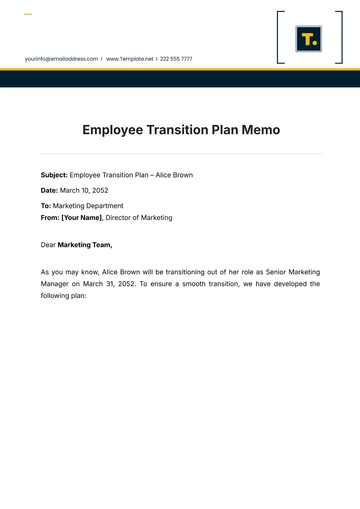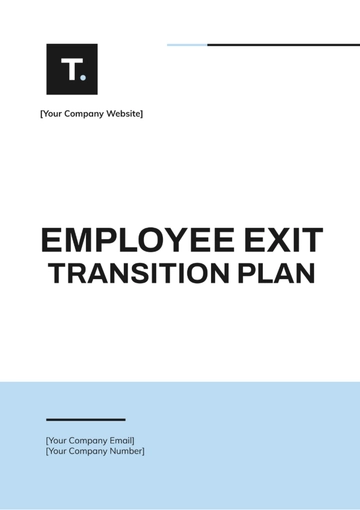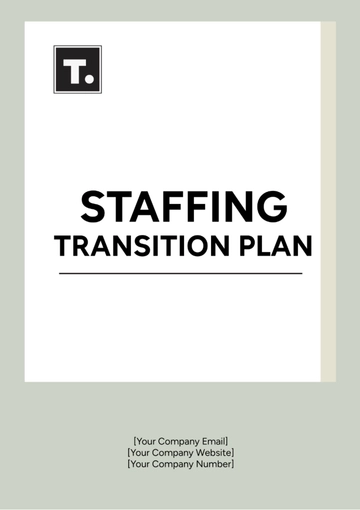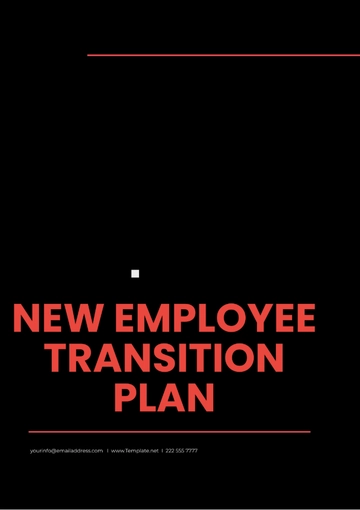Free Employee Retirement Transition Plan
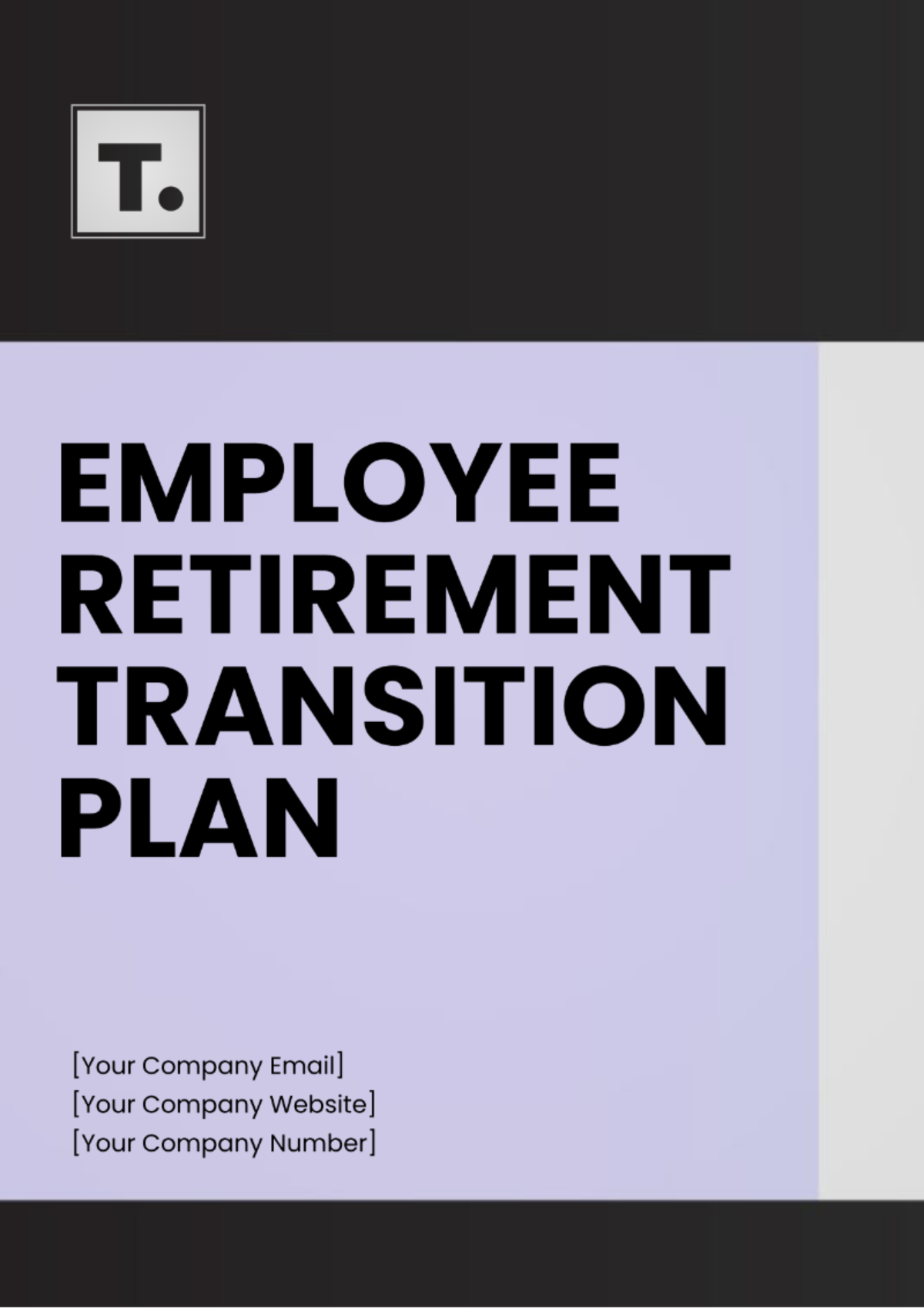
Prepared By : | [YOUR NAME] |
Department : | [YOUR DEPARTMENT] |
Date Prepared : | [DATE] |
I. Introduction
As part of our commitment to our employees and the continuity of our organization, we have developed an Employee Retirement Transition Plan. This plan is designed to ensure a smooth and respectful exit for retiring employees while safeguarding organizational continuity. By facilitating comprehensive knowledge transfer, succession planning, and providing personalized support, we aim to honor the retiring employee's contributions, preserve institutional knowledge, and sustain productivity. Our focus is on creating a positive farewell experience while preparing the organization for the transition ahead.
II. Purpose
The purpose of this plan is to provide retiring employees with the necessary resources and support to transition out of the organization smoothly while minimizing disruption to operations. Additionally, it aims to preserve critical knowledge and expertise within the organization and facilitate the transfer of responsibilities to successor employees.
III. Key Components
A. Retirement Counseling and Support
Retiring employees will have access to retirement counseling services to help them navigate the transition process. This includes guidance on financial planning, healthcare options, and emotional support.
Service Offering | Description |
|---|---|
Financial Planning | Personalized financial planning sessions to help retiring employees navigate retirement savings, investments, and budgeting. |
Healthcare Options | Guidance on available healthcare options post-retirement, including Medicare, private insurance, and healthcare savings accounts. |
Emotional Support | Counseling services to assist retiring employees in managing the emotional aspects of retirement and adjusting to life changes. |
B. Knowledge Transfer
Retiring employees will work with their supervisors to identify key job responsibilities and knowledge that need to be transferred to their successors. This may include documentation, training sessions, and shadowing opportunities.
Activity | Description |
|---|---|
Documentation | Retiring employees will document key processes, procedures, and contacts to facilitate knowledge transfer to successors. |
Training Sessions | Retiring employees will conduct training sessions with their successors to impart critical job knowledge and skills. |
Shadowing Opportunities | Successors will shadow retiring employees to observe day-to-day responsibilities and gain hands-on experience before assuming full responsibility. |
C. Succession Planning
The HR department will work closely with supervisors to identify potential successors for retiring employees and ensure they are adequately prepared to assume their new roles. Succession plans will be developed and implemented to mitigate any potential gaps in leadership or expertise.
Key Activities | Responsible Party | Timeline |
|---|---|---|
Identify Potential Successors | HR Department, Supervisors | 3 months before retirement |
Develop Succession Plans | HR Department, Supervisors | 2 months before retirement |
Implement Succession Plans | HR Department, Supervisors | Upon retirement |
D. Documentation and Exit Interviews
Retiring employees will be required to complete necessary documentation related to their retirement, including finalizing any outstanding projects and updating job manuals or procedures. Exit interviews will be conducted to gather feedback and insights from retiring employees to improve our retirement transition process.
Documentation Tasks | Description | Timeline |
|---|---|---|
Finalize Projects | Ensure completion or handover of ongoing projects and tasks. | 1 month before retirement |
Update Job Manuals | Review and update job manuals, procedures, and documentation. | 2 weeks before retirement |
Conduct Exit Interviews | Gather feedback and insights from retiring employees to improve the retirement transition process. | Upon retirement |
E. Farewell Celebration
A farewell celebration will be organized to honor the retiring employee's contributions and achievements. This may include a retirement party, presentation of gifts or awards, and speeches from colleagues and supervisors.
Event Planning | Description | Timeline |
|---|---|---|
Venue Booking | Reserve a venue for the farewell celebration, considering the retiring employee's preferences. | 2 months before retirement |
Invitations | Send out invitations to colleagues, supervisors, and other stakeholders for the farewell event. | 1 month before retirement |
Program Arrangement | Plan the program, including speeches, presentations, and entertainment, to honor the retiring employee. | 2 weeks before retirement |
IV. Timeline
The retirement transition process will typically begin six months before the employee's planned retirement date to allow for adequate preparation and planning. However, timelines may vary depending on individual circumstances and organizational needs.
V. Responsibilities
HR Department: Responsible for overseeing the retirement transition process, providing support to retiring employees, and coordinating with supervisors and other departments.
Supervisors: Responsible for identifying key job responsibilities and knowledge to be transferred, developing succession plans, and providing support to retiring employees during the transition process.
Retiring Employees: Responsible for actively participating in the retirement transition process, completing necessary documentation, and assisting with knowledge transfer activities.
VI. Conclusion
This Employee Retirement Transition Plan is designed to ensure a seamless and respectful exit for retiring employees while safeguarding organizational continuity. By providing comprehensive support, facilitating knowledge transfer, and planning for succession, we aim to honor the retiring employee's contributions and prepare the organization for the transition ahead. We are committed to creating a positive farewell experience for retiring employees and ensuring the long-term success of our organization.
- 100% Customizable, free editor
- Access 1 Million+ Templates, photo’s & graphics
- Download or share as a template
- Click and replace photos, graphics, text, backgrounds
- Resize, crop, AI write & more
- Access advanced editor
Ensure smooth retirement transitions with the Employee Retirement Transition Plan Template from Template.net. This fully customizable and editable template offers a structured approach to managing retirements. Easily tailor it to your needs using our intuitive Ai Editor Tool. Maintain efficiency and professionalism during transitions with this comprehensive, user-friendly template from Template.net. Simplify the retirement process today.
You may also like
- Finance Plan
- Construction Plan
- Sales Plan
- Development Plan
- Career Plan
- Budget Plan
- HR Plan
- Education Plan
- Transition Plan
- Work Plan
- Training Plan
- Communication Plan
- Operation Plan
- Health And Safety Plan
- Strategy Plan
- Professional Development Plan
- Advertising Plan
- Risk Management Plan
- Restaurant Plan
- School Plan
- Nursing Home Patient Care Plan
- Nursing Care Plan
- Plan Event
- Startup Plan
- Social Media Plan
- Staffing Plan
- Annual Plan
- Content Plan
- Payment Plan
- Implementation Plan
- Hotel Plan
- Workout Plan
- Accounting Plan
- Campaign Plan
- Essay Plan
- 30 60 90 Day Plan
- Research Plan
- Recruitment Plan
- 90 Day Plan
- Quarterly Plan
- Emergency Plan
- 5 Year Plan
- Gym Plan
- Personal Plan
- IT and Software Plan
- Treatment Plan
- Real Estate Plan
- Law Firm Plan
- Healthcare Plan
- Improvement Plan
- Media Plan
- 5 Year Business Plan
- Learning Plan
- Marketing Campaign Plan
- Travel Agency Plan
- Cleaning Services Plan
- Interior Design Plan
- Performance Plan
- PR Plan
- Birth Plan
- Life Plan
- SEO Plan
- Disaster Recovery Plan
- Continuity Plan
- Launch Plan
- Legal Plan
- Behavior Plan
- Performance Improvement Plan
- Salon Plan
- Security Plan
- Security Management Plan
- Employee Development Plan
- Quality Plan
- Service Improvement Plan
- Growth Plan
- Incident Response Plan
- Basketball Plan
- Emergency Action Plan
- Product Launch Plan
- Spa Plan
- Employee Training Plan
- Data Analysis Plan
- Employee Action Plan
- Territory Plan
- Audit Plan
- Classroom Plan
- Activity Plan
- Parenting Plan
- Care Plan
- Project Execution Plan
- Exercise Plan
- Internship Plan
- Software Development Plan
- Continuous Improvement Plan
- Leave Plan
- 90 Day Sales Plan
- Advertising Agency Plan
- Employee Transition Plan
- Smart Action Plan
- Workplace Safety Plan
- Behavior Change Plan
- Contingency Plan
- Continuity of Operations Plan
- Health Plan
- Quality Control Plan
- Self Plan
- Sports Development Plan
- Change Management Plan
- Ecommerce Plan
- Personal Financial Plan
- Process Improvement Plan
- 30-60-90 Day Sales Plan
- Crisis Management Plan
- Engagement Plan
- Execution Plan
- Pandemic Plan
- Quality Assurance Plan
- Service Continuity Plan
- Agile Project Plan
- Fundraising Plan
- Job Transition Plan
- Asset Maintenance Plan
- Maintenance Plan
- Software Test Plan
- Staff Training and Development Plan
- 3 Year Plan
- Brand Activation Plan
- Release Plan
- Resource Plan
- Risk Mitigation Plan
- Teacher Plan
- 30 60 90 Day Plan for New Manager
- Food Safety Plan
- Food Truck Plan
- Hiring Plan
- Quality Management Plan
- Wellness Plan
- Behavior Intervention Plan
- Bonus Plan
- Investment Plan
- Maternity Leave Plan
- Pandemic Response Plan
- Succession Planning
- Coaching Plan
- Configuration Management Plan
- Remote Work Plan
- Self Care Plan
- Teaching Plan
- 100-Day Plan
- HACCP Plan
- Student Plan
- Sustainability Plan
- 30 60 90 Day Plan for Interview
- Access Plan
- Site Specific Safety Plan
